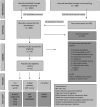The detection of delirium in admitted oncology patients: a scoping review
- PMID: 35032322
- PMCID: PMC8860783
- DOI: 10.1007/s41999-021-00586-1
The detection of delirium in admitted oncology patients: a scoping review
Abstract
Purpose: Delirium leads to poor outcomes for patients and careers and has negative impacts on staff and service provision. Cancer rates in elderly populations are increasing and frequently, cancer diagnoses are a co-morbidity in the context of frailty. Data relating to the epidemiology of delirium in hospitalised cancer patients are limited. With the overarching purpose of improving delirium detection and reducing the morbidity and mortality of delirium in cancer patients, we reviewed the epidemiological data and approach to delirium detection in hospitalised, adult oncology patients.
Methods: MEDLINE, EMBASE, CINAHL, PsycINFO, and SCOPUS databases were searched from January 1996 to August 2017. Key concepts were delirium, cancer, inpatient oncology and delirium screening/detection.
Results: Of 896 unique studies identified; 91 met full-text review criteria. Of 12 eligible studies, four applied recommended case ascertainment methods to all patients, three used delirium screening tools alone or with case ascertainment tools sub-optimally applied, four used tools not recommended for delirium screening or case ascertainment, one used the Confusion Assessment Method with insufficient information to determine if it met case ascertainment status. Two studies presented delirium incidence rates: 7.8%, and 17% respectively. Prevalence rates ranged from 18-33% for general medical or oncology wards; 42-58% for Acute Palliative Care Units (APCU); and for older cancer patients: 22% and 57%. Three studies reported reversibility; 26% and 49% respectively (APCUs) and 30% (older patients with cancer). Six studies had a low risk of bias according to QUADAS-2 criteria; all studies in the APCU setting were rated at higher risk of bias. Tool selection, study flow and recruitment bias reduced study quality.
Conclusion: The knowledge base for improved interventions and clinical care for adults with cancer and delirium is limited by the low number of studies. A clear distinction between screening tools and diagnostic tools is required to provide an improved understanding of the rates of delirium and its reversibility in this population.
Keywords: Cancer; Delirium; Detection; Inpatient; Oncology; Screening.
© 2022. Crown.
Conflict of interest statement
No authors have conflicting/competing interest.
Figures
References
-
- American Psychiatric Association (2013) Diagnostic and statistical manual of mental disorders (DSM-5®). American Psychiatric Pub.
-
- Ljubisavljevic V, Kelly B. Risk factors for development of delirium among oncology patients. Gen Hosp Psychiatry. 2003;25(5):345–352. - PubMed
-
- Breitbart W, Gibson C, Tremblay A. The delirium experience: delirium recall and delirium-related distress in hospitalized patients with cancer, their spouses/caregivers, and their nurses. Psychosomatics. 2002;43(3):183–194. - PubMed
Publication types
MeSH terms
LinkOut - more resources
Full Text Sources
Medical
Miscellaneous

